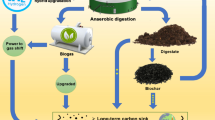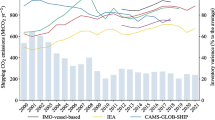Abstract
This study aims to estimate the emissions of carbon dioxide (CO2), sulfur dioxide (SO2), and nitric oxide (NO) for coal combustion in thermal power plants in India using plant-specific emission factors during the period of 2001/02 to 2009/10. The mass emission factors have been theoretically calculated using the basic principles of combustion under representative prevailing operating conditions in the plants and fuel composition. The results show that from 2001/02 to 2009/10 period, total CO2 emissions have increased from 324 to 499 Mt/year; SO2 emissions have increased from 2,519 to 3,840 kt/year; and NO emissions have increased from 948 to 1,539 kt/year from the Indian coal-fired power plants. National average emissions per unit of electricity from the power plants do not show a noticeable improvement during this period. Emission efficiencies for new plants that use improved technology are found to be better than those of old plants. As per these estimates, the national average of CO2 emissions per unit of electricity varies between 0.91 and 0.95 kg/kWh while SO2 and NO emissions vary in the range of 6.9 to 7.3 and 2.8 to 2.9 g/kWh, respectively. Yamunagar plant in Haryana state showed the highest emission efficiencies with CO2 emissions as 0.58 kg/kWh, SO2 emissions as 3.87 g/kWh, and NO emissions as 1.78 g/kWh, while the Faridabad plant has the lowest emission efficiencies with CO2 emissions as 1.5 kg/kWh, SO2 emissions as 10.56 g/kWh, and NO emissions as 4.85 g/kWh. Emission values at other plants vary between the values of these two plants.
Similar content being viewed by others
Notes
In India, the data are recorded on financial year basis, which starts from1 April of a year and finish on 31st March of the following year and hence covers parts of two subsequent calendar years.
References
Bartonova, L., Juchelkova, D., Klika, Z., & Cech, B. (2011). On unburned carbon in ash from various combustion units. World Academy of Science, Engineering and Technology, 76, 352–355. ISSN 2010-376X.
CEA (2010). ). Central Electricity Authority. Reviews of performance of thermal power stations 2009-10. http://www.cea.nic.in/reports/yearly/thermal_perfm_review_rep/0910/highlights.pdf. Accessed 22 Dec 2012.
CEA (2014). Central Electricity Authority. Baseline carbon dioxide emission from power sector, http://www.cea.nic.in/reports/planning/cdm_co2/cdm_co2.htm. Accessed 4 June 2014.
Chakraborty, N., Mukherjee, I., Santra, A. K., Chowdhury, S., Chakraborty, S., Bhattacharya, S., Mitra, A. P., & Sharma, C. (2008). Measurement of CO2, CO, SO2, and NO emissions from coal-based thermal power plants in India. Atmospheric Environment, 42, 1073–1082.
Choudhury, A., Roy, J., Biswas, S., Chakraborty, C. C., & Sen, K. (2004). Determination of carbon dioxide emission factors from coal combustion. In A. P. Mitra et al. (Eds.), Climate Change and India: Uncertainity Reduction in GHG Inventories. Hyderabad: University Press (India) Pvt. Ltd.
CIA (2012). Energy electricity consumption and generation in India; CIA World Fact Book. www.indexmundi.com/g/g.aspx?c=in&v=81. Accessed on 26 March 2013.
CMPDI. (1993). Coal Atlas of India. Ranchi: Central Mine Planning and Defense Institute.
CPCB (2010). Pollution control law, series: PCI 2/02/2010, The environment (Protection) rules, 1986; www.cpcb.nic.in/newItem_19_PollutionControlLaw.pdf. Accessed on 2 February 2012
Garg, A., & Shukla, P. R. (2002). Emission inventory of India. New Delhi: Tata McGraw-Hill Publishing Company Limited.
Garg, A., Kapse, M., Shukla, P. R., & Ghosh, D. (2002). Large point source (LPS) emissions from India: Regional and sect oral analysis. Atmospheric Environment, 36, 213–224.
Garg, A., Shukla, P. R., & Kapse, M. (2006). The sectoral trends of multigas emissions inventory of India. Atmospheric Environment, 40, 4608–4620.
Hanby, V. I. (1994). Combustion and pollution control in heating systems. London: Springer-Verlag.
INCCA. (2010). India: greenhouse gas emissions 2007. India: Indian Network for Climate Change Assessment, Ministry of Environment & Forests.
IPCC (1996). IPCC Guidelines for National Greenhouse Gas Inventories. Revised. In J. T., Houghton & B. A. Bracknell (eds.), IPCC/OECD/IEA, UK Meteorological Office.
IPCC (Intergovernmental Panel on Climate Change) (2006). IPCC Guidelines for National Greenhouse Gas Inventories. Task Force on National Greenhouse Gas Inventories, IPCC.
Mandal, P. K. (2008). High unburnt carbon problem in fly ash and bottom ash in some Indian stations. Water & Energy International, 65, 34-44. http://www.indianjournals.com/ijor.aspx?target=ijor:wei&volume=65&issue=3&article=006. Accessed on 4 April 2013.
Ministry of Power (2001). Government of India, Annual Report 2001-02. www.powermin.nic.in. Accessed on 18 February 2011.
Mitchell, J. W., & Tarbell, J. M. (1982). A kinetic model of nitric oxide formation during pulverized coal Combustion. American Institute of Chemical Engineers Journal, 28, 302–311.
Mittal, M. & Sharma, C. (2001). Anthropogenic emissions from energy activities in India, generation and source characterization. Part I. http://www.osc.edu/research/archieve/pcrm/emissions. Accessed on 20 February 2012.
NATCOM. (2004). India’s Initial National Communication to the United Nations Framework Convention on Climate Change. Government of India: Ministry of Environment and Forests.
Olivier, J. G. J., Bouwman, A. F., Berdowski, J. J. M., Veldt, C., Bloos, J. P. J., Visschediik, A. J. H., van der Maas, C. W. M., & Zandveld, P. Y. J. (1999). Sect oral emission inventories of greenhouse gases for 1990 on a per country basis as well as 10x10. Environmental Science & Pollution, 2, 241–263.
Pfister, G. G., Emmons, L. K., Edwards, D. P., Arellano, A., Sachse, G., & Campos, T. (2010). Variability of springtime transpacific pollution transport during 2000-2006: The INTEX-B mission in the context of previous years. Atmospheric Chemistry & Physics, 10, 1345–1359.
Reddy, M. S., & Venkataraman, C. (2002). Inventory of aerosol and sulfur dioxide emissions from India: I. Fossil fuels combustion. Atmospheric Environment, 36, 677–697.
Rees, O. W., Shimp, N. F., Beeler, C. W., Kuhn, J. K., & Helfinstine, R. J. (1966). Sulfur retention in bituminous coal ash. Urbana, Circular: Illinois State Geological Survey. 396.
Sathyanathan, V. T., & Mohammad, K. P. (2004). Prediction of unburnt carbon in tangentially fired boiler using Indian coals. Fuel, 83, 2217–2227.
Spiro, P. A., Jacob, D. J., & Logan, J. A. (1992). Global inventory of sulfur emissions with 1° X 1 ° resolution. Journal of Geophysical Research, 97, 6023–6036.
USAID/TVA/NTPC, 2000. Heat rate improvement guidelines for Indian power plants. (http://www.ntpc.co.in/index.php?option=com_content&view=article&id=23&Itemid=96&lang=en . Accessed on 2 February 2012.
Visuvasam, D., Selvaraj, P., Sekar, S. (2005). Influence of coal properties on particulate emission control in thermal power plants in India. Second International Conference on Clean Coal Technologies for Our Future. Sardinia, Italy, sponsored by IEA Clean Coal Centre, Gemini House, 10-18 Putney Hill, London, SW15 6AA. UK
World Bank (2000). World Development Indicators—Annual Report of the World Bank on Development Indicators. (www.worldbank.org/data/wdi2000/pdfs/tab3-7.pdf, tab3-8.pdf, and /country data/aag/ind-aag.pdf). Accessed on 5 January 2012
Zeldovich, J. (1946). The oxidation of nitrogen in combustion and explosions. Acta physicochimica URSS, 21, 557.
Acknowledgments
The authors are grateful to Prof. Noreen Poor for her suggestions and help in editing the manuscript. The authors are also thankful to the scientists of the CSIR-Central Mining and Fuel Research Institute, Dhanbad, and the engineers of several power plants that include Indra Prashtha, Dadri, Faridabad, Panipat, Dhuvran, Chandrapur, and Neyvelli for their help. C. Sharma and R. Singh are also grateful to the Director, National Physical Laboratory (CSIR-NPL), New Delhi, and the Head, RASD, NPL, New Delhi, for their support.
Author information
Authors and Affiliations
Corresponding author
Appendix
Appendix
Rights and permissions
About this article
Cite this article
Mittal, M.L., Sharma, C. & Singh, R. Decadal emission estimates of carbon dioxide, sulfur dioxide, and nitric oxide emissions from coal burning in electric power generation plants in India. Environ Monit Assess 186, 6857–6866 (2014). https://doi.org/10.1007/s10661-014-3894-3
Received:
Accepted:
Published:
Issue Date:
DOI: https://doi.org/10.1007/s10661-014-3894-3




